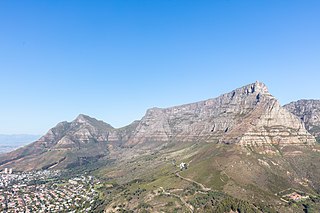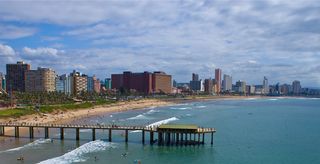Related Research Articles

Cape Town is the second-most populous city in South Africa, after Johannesburg, and also the legislative capital of South Africa.

Table Mountain is a flat-topped mountain forming a prominent landmark overlooking the city of Cape Town in South Africa. It is a significant tourist attraction, with many visitors using the cableway or hiking to the top. The mountain forms part of the Table Mountain National Park, and part of the lands formerly ranged by Khoe-speaking clans, such as the !Uriǁʼaes. It is home to a large array of mostly endemic fauna and flora.

Masiphumelele is a township on the Cape Peninsula, South Africa, situated between Kommetjie, Capri Village and Noordhoek.

Kommetjie is a small town near Cape Town, in the Western Cape province of South Africa. It lies about halfway down the west coast of the Cape Peninsula, at the southern end of the long wide beach that runs northwards towards Chapman's Peak and Noordhoek.

Fish Hoek is a coastal suburb at the eastern end of the Fish Hoek Valley on the False Bay side of the Cape Peninsula in the Western Cape, South Africa. Previously a separate municipality, Fish Hoek is now part of the City of Cape Town. As a coastal suburb of Cape Town, Fish Hoek is popular as a residence for commuters, retired people and holidaymakers alike. The traditional industries of 'trek' fishing and angling coexist with the leisure pursuits of surfing, sailing and sunbathing. There is an active lifeguard community who utilise the beach and bay for training.

False Bay is a body of water in the Atlantic Ocean between the mountainous Cape Peninsula and the Hottentots Holland Mountains in the extreme south-west of South Africa. The mouth of the bay faces south and is demarcated by Cape Point to the west and Cape Hangklip to the east. The north side of the bay is the low-lying Cape Flats, and the east side is the foot of the Hottentots Holland Mountains to Cape Hangklip which is at nearly the same latitude as Cape Point. In plan the bay is approximately square, being roughly the same extent from north to south as east to west, with the southern side open to the ocean. The seabed slopes gradually down from north to south, and is mostly fairly flat unconsolidated sediments. Much of the bay is off the coast of the City of Cape Town, and it includes part of the Table Mountain National Park Marine Protected Area and the whole of the Helderberg Marine Protected Area. The name "False Bay" was applied at least three hundred years ago by sailors returning from the east who confused Cape Point and Cape Hangklip, which are somewhat similar in form.

Hout Bay is a seaside suburb of Cape Town in the Western Cape province of South Africa. It is situated in a valley on the Atlantic seaboard of the Cape Peninsula, twenty kilometres south of the Central Business District. The name "Hout Bay" can refer to the suburb, the bay on which it is situated, or the entire valley.

Noordhoek is a seaside town in the Western Cape, South Africa, located below Chapman's Peak on the west coast of the Cape Peninsula and is approximately 35 kilometres (22 mi) to the south of Cape Town. The name "Noordhoek" was taken from Dutch and literally means "north corner". It is best known for its shoreline and its long, wide, sandy beach, which stretches south to the neighbouring village of Kommetjie. Near the southern end of this beach is the wreck of the steamship "Kakapo", which ran aground in 1900, when the captain mistook Chapmans' Peak for the Cape of Good Hope and put the helm over to port.

Table Mountain National Park, previously known as the Cape Peninsula National Park, is a national park in Cape Town, South Africa, proclaimed on 29 May 1998, for the purpose of protecting the natural environment of the Table Mountain Chain, and in particular the rare fynbos vegetation. The park is managed by South African National Parks. The property is included as part of the UNESCO Cape Floral Region World Heritage Site.
short description|List of beaches in the Cape Town metropolitan region Image:Muizenberg ZA bathing huts.jpg|thumb|right|250px|[Muizenbergbeach The Cape Metropole has a wide variety of beaches divided into three regions by the Cape Peninsula:

The M3 is an expressway in Cape Town, South Africa, connecting the upper part of the City Bowl to the Southern Suburbs and ending in Tokai. For most of its route it parallels - though further to the south and west - the M4, which was the original road connecting central Cape Town with the settlements to the south.

Capri Village is a small suburb of Cape Town on the Cape Peninsula, South Africa, situated between Kommetjie, Fish Hoek and Noordhoek.

Simon's Town railway station is a Metrorail railway station in the town of Simon's Town on the Cape Peninsula; it is the southern terminus of the Southern Line. The station is located between Station Road and the beach.

Cape Town lies at the south-western corner of the continent of Africa. It is bounded to the south and west by the Atlantic Ocean, and to the north and east by various other municipalities in the Western Cape province of South Africa.

Glencairn is a suburb of Cape Town, South Africa. It is situated about 4 km north of Simonstown, on the shore of False Bay. Access can be made from Fish Hoek or Simonstown via the M4, or from Noordhoek via the M6. Glencairn is made up of Glencairn Heights, Glen Ridge and Welcome Glen. There is a train stop at the south end of the suburb, with views across False Bay. The beach is actively utilised for leisure activities such as swimming, surfing, kayaking and snorkeling. The Glencairn tidal pool can be enjoyed on a high tide at the south end of the beach. The Glencairn Wetland conserves the lower Else River.

Ou Kaapse Weg, numbered as route M64, is a mountain pass in the Cape Peninsula that connects the Southern Suburbs of Cape Town with the Fish Hoek Valley. It traverses the Steenberg mountains and passes through the Silvermine Nature Reserve. Ou Kaapse Weg is one of three routes to the Fish Hoek Valley: the others are Chapman's Peak Drive along the Atlantic coast and Main Road along the False Bay coast. Despite its name, the pass was only constructed in 1968, by the Divisional Council of the Cape.

Fish Hoek Library is a public library in the seaside suburb of Fish Hoek in Cape Town, South Africa. It was ranked 5th in the City of Cape Town's top circulating libraries in 2015

The following outline is provided as an overview of and topical guide to Cape Town:

This is a list of seaside resorts in South Africa. These seaside resorts are in the Eastern Cape, KwaZulu-Natal, Northern Cape and Western Cape provinces which are all coastal provinces of South Africa.
References
- ↑ "Archived copy". Archived from the original on 2012-12-23. Retrieved 2013-05-06.CS1 maint: discouraged parameter (link) CS1 maint: archived copy as title (link)
- ↑ MacPhee, D. & De Wit, M. (2003) How the Cape Got its Shape.
- 1 2 3 4 5 Midgley, J.F. (1984). Kommetjie CP - Its Story.
- ↑ Burman, J. (1977). The False Bay Story.
- ↑ Act 14 of 1903 (Cape Colony)
- 1 2 3 4 5 6 Annual Report of the Divisional Council of the Cape
- ↑ Cole, J. 'Revolt a symptom of historical pain' in Cape Argus (8 August 2008)
- 1 2 Green, L.G. (1947). Tavern of the Seas.
- ↑ Greenland, C. (1978) The Story of Peers Cave
- Burman, J. (1977). The False Bay Story.
- Cobern, M. (1984). The Story of the Fish Hoek Valley.
- Green, L.G. (1947). Tavern of the Seas.
- Green, L.G. (1951). Grow Lovely, Growing Old.
- Greenland, C. (1966). Before We Forget.
- Greenland, C. (1978). The Story of Peers Cave.
- MacPhee, D. & De Wit, M. (2003). How the Cape Got its Shape.
- Midgley, J.F. (1984). Kommetjie CP - Its Story.
- Rosenthal, E. (1968) A History of Fish Hoek 1818-1968.
